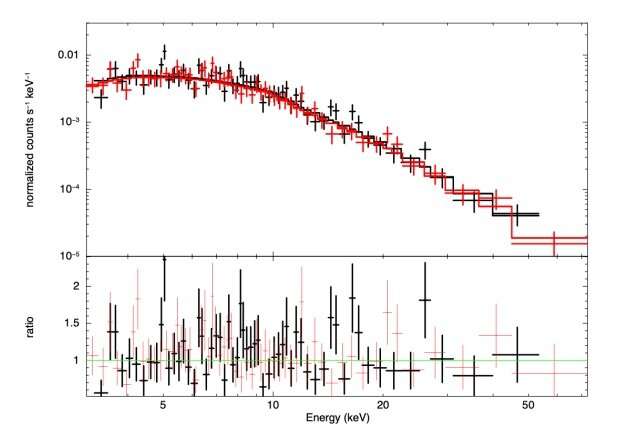April 18, 2022 report
Study investigates flaring activity of blazar S5 1803+78

Using various space and ground-based observatories, astronomers have inspected flaring activity observed on a blazar known as S5 1803+78. Results of this multi-wavelength study, published April 10 on the arXiv pre-print server, shed more light on the properties of this source.
Blazars are very compact quasars associated with supermassive black holes (SMBHs) at the centers of active, giant elliptical galaxies. They belong to a larger group of active galaxies that host active galactic nuclei (AGN), and are the most numerous extragalactic gamma-ray sources. Their characteristic features are relativistic jets pointed almost exactly toward the Earth.
Based on their optical emission properties, astronomers divide blazars into two classes: flat-spectrum radio quasars (FSRQs) that feature prominent and broad optical emission lines, and BL Lacertae objects (BL Lacs), which do not.
At a redshift of 0.684, S5 1803+78 is a low-synchrotron peak (LSP) blazar of BL Lac type. It showcases a periodicity of 6 years, which is linked to the helical jet motion. Previous observations have detected several large flares of this blazar on a possible timescale of about 3.5 years.
A team of astronomers led by Shruti Priya of the Indian Institute of Technology in Kharagpur, India, decided to conduct a multi-wavelength observational campaign of S5 1803+78 in order to better understand its flaring behavior. For this purpose, they employed several spacecraft and telescopes, including NASA's Swift, Fermi and NuSTAR, or the TUBITAK National Observatory in Turkey.
"In this paper, we present the broadband study of the source collecting the data from radio to gamma-ray.The broadband SED [spectral energy distribution] modeling is performed to understand the multi-wavelength flaring events in the source," the researchers wrote.
By analyzing the gamma-ray light curve of S5 1803+78, the team managed to identify three flaring states of this source. They investigated the flaring episodes along with the pre-flaring region since September 1, 2019. A major flare was recorded in April 2020, which was followed by more flaring episodes. The fastest variability timescale was found to be 0.95 days and no significant correlation between gamma-ray, radio, and also X-ray has been identified.
According to the study, S5 1803+78 showcases the so-called bluer when brighter (BWB) trend. The highest energy photon during the big flare was measured to be 11.17 GeV. The research also found that flux does not show any significant correlation with the spectral index and that there is only a minor anti-correlation with the curvature index.
All in all, the results suggest that the emission region in S5 1803+78 is compact and located close to the central supermassive black hole. The size of this region was estimated to be about 100 trillion kilometers.
More information: Shruti Priya et al, Multi-wavelength temporal and spectral analysis of Blazar S5 1803+78, arXiv:2204.04739 [astro-ph.HE], arxiv.org/abs/2204.04739
© 2022 Science X Network



















